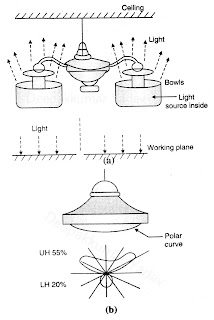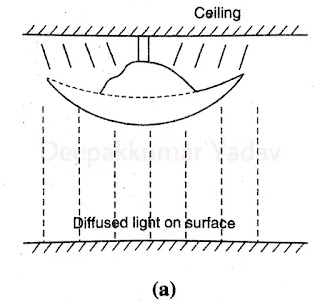Lighting Schemes :
For different purposes different lighting schemes are suggested.
Types of Lighting Schemes :
(a) Direct Lighting.
(b) Semi-direct Lighting.
(c) Semi-indirect Lighting.
(d) Indirect Lighting.
(e) General Lighting.
(a) Direct Lighting Schemes :
UL - Upper hemisphere
(b) Semi-Direct Lighting Schemes :
For different purposes different lighting schemes are suggested.
Types of Lighting Schemes :
- If the light falls on the polished surface the light is reflected back. This is good for illuminated but it produces glare on the eyes which is harmful.
- If light falls on the coarse surfaces like painted ceilings, frosted glass or paper. The light is diffused in all the directions so no effect of glare on the eyes. So this method is used for internal or external lightings.
(a) Direct Lighting.
(b) Semi-direct Lighting.
(c) Semi-indirect Lighting.
(d) Indirect Lighting.
(e) General Lighting.
(a) Direct Lighting Schemes :
- By this method most of the light source is made available on the working surface and very few percent is wasted.
- The light energy is lighting sources, are hung and light Is diverted by proper shaped reflectors or globs. co number of light units needed are less and overall cost of the illumination scheme is reduced.
- Though this system is most efficient, the drawback of the system is that dark shadows fall on the working plate moreover there is a glare on the eyes.
UL - Upper hemisphere
(b) Semi-Direct Lighting Schemes :
- In this scheme, about 60 to 90% of total light flux is made to fall on the working surface and 10 to 40% is allowed to fall on the ceiling and walls.
- This is achieved by providing semi-direct reflectors. Such a scheme is best suited to rooms having bigger heights. Glare is avoided and diffused bulbs are used.
- In this system, 60 to 90 % of the total light flux is diverted to fall on the ceilings from where the light is directed on the working surface by diffused reflection. Only 30 to 40 % flux reaches the working plane. Some is absorbed by the bowls.
- This provides pleasant lighting, free from glare and shadows are very soft. Scheme is costly. But it is used for indoor decoration purposes. Bowls are semi-translucent type.
- The light does not reach the working surface directly. The maximum light (about 90 %) is thrown towards the ceilings for diffused reflection by using inverted reflectors or bowl reflectors.
- As if the ceiling acts as a light source therefore the glare is reduced to the minimum value. Illumination is pleasant, defused and very soft and shadows are illuminated.
- Scheme is decorative. This scheme is suggested for function halls, cinema theatres, three star hotels. Also suggested for big workshops in the industries to avoid accidents due to shadows.
- Special diffusing glasses are used for lamps which spread the light uniformly on tile working plane. The light illumination is equal in all directions.
- Following Figure (12) gives the idea of all the above five types in a schematic diagram with percentage division of light illumination.
Figure (12)
- Direct fitting (90 to 100% downwards)
- Semi-direct fitting (75% downwards)
- General fitting(50% downwards).
- Semi-indirect fitting(25% downwards)
- Indirect fitting (10% downwards)









well formatted with proper understanding and visualisation
ReplyDelete